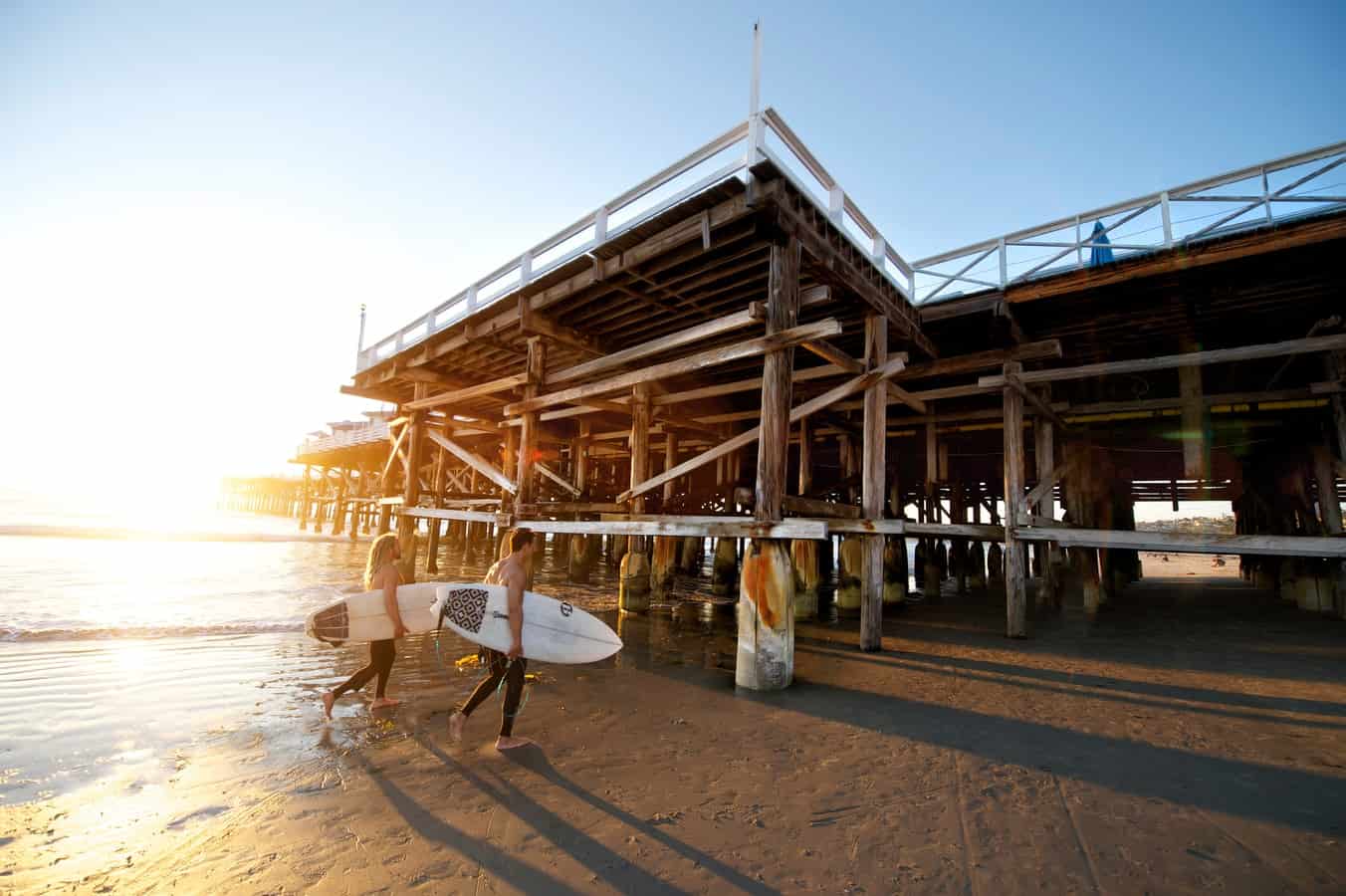Riding your surfboard along a wave tube is one of the most perfect and sublime experiences one can have. Both patience and tenacity are the main qualities surfers have because waves don’t always cooperate, so surfers experience one wipeout after the other until the right one comes along. A surfboard leash attached to the end of the surfboard ensures the board stays close after a wipeout.
How long should my surfboard leash be? As a general rule, the surfboard leash should be the length of your surfboard. Always round up the size of the leash if your board is between sizes. For example, if your board is 6 feet 7 inches, get a leash that’s 7 feet in length. On the other hand, if you have a longboard and it’s exactly 9 feet in length, use a leash that’s 9 feet long.
Surfboards range in size from about 5 feet long to the 12-foot long gun board. The most popular is the shortboard which is anywhere from 6 feet to 7 ½ feet long. Knowing the size that’s best for you will make for a more satisfying surfing experience.
What Size Surfboard Should A Beginner Surfer Get?
The surfboard size and type that’s right for you is based on how much surfing experience you have, your body type (short or tall) and your body weight. Surfers are within one of these following classes:
- Beginner
- Intermediate
- Advanced
- Professional
If you’re just starting, in the beginner class, opt for a thicker and longer surfboard. Thicker boards allow you to float better and are stable enough so you can paddle towards your first waves and stay balanced on the board longer as you ride waves.
A surfer who is taller and heavier would use a board that’s bigger instead of the lighter, shorter board that an intermediate surfer uses.
Beginner Surfers
Surfboards designed for the beginner surfer are more buoyant. You’ll be able to remain standing on your board rather than wiping out so often after catching a wave. These boards allow you to commit more errors as you surf, allowing you to remain standing through the curve.
The surfboard you buy should have a soft top, allowing you to catch as many waves as you can while learning surfing skills. You’ll be mostly surfing in white water, and a soft top allows you to paddle quickly to the wave, then ride and fall, get back up again as rapidly as possible.
The boards are lighter and more stable, so they are much easier to manage. Make sure you complement your board with a surfboard leash to keep your board close to you once you move up to bigger and more challenging waves.
Foam surfboards range from about 6 feet to a little over 9 feet. Average size adults would ride a board between 8 and 9 feet, while children and younger teens will start on boards about 6 feet long.
As board size increases, so does your chance of catching more massive waves. Beginner surfboards are not expensive. Once you graduate to an intermediate and even an advanced surfboard, you can use your foam board to perfect your riding skills. Beginner boards are great to fine-tune your skills. Remember that the pros riding waves today started on foam boards and return to them to tweak their movements.
You can also use a pop out surfboard that is made out of molded plastic, or even a board with thick resin for better grip.
Foam surfboards have an added feature to improve your surfing experience dramatically: stringers. A stringer is a strip of wood made for the water that runs from the nose to the tail of the surfboard. This center stringer makes the foam board stiffer and more rigid. This helps the foam board be more resistant to the water current and helps you when paddling towards a wave.
When buying a board either online or in a surf shop, make sure to get the board that’s right for your weight and height. A shortboard would be of no use to a tall, heavy rider, nor would a 9-foot board work well for a thin and shorter surfer.

What Type Of Board Is Right For Intermediate Level Surfers?
The best way to know what size surfboard is right if you’re an intermediate level surfer is that the board should be one hand palm higher than your height. Intermediate level surfers can use either a longboard that is 9 feet or longer for a funboard,
A funboard (or Malibu board), is the fiberglass version of the foam board. Funboards are the next level after you’ve learned on a soft top board as mentioned above.
Now that you’ve developed intermediate level surfboarding skills, you will start to make more sophisticated moves each time you approach a wave. It’s called a funboard because its length and width are perfect for riding in terms of its length, width, and thickness. They’re not thin or narrow, so using a fun board is…fun! Thinner, shorter, and narrower boards fall are categorized as “performance boards” because of the way they can maneuver quickly and deftly through current and rising waves.
There are three skills an intermediate surfer wants to learn on a funboard.
- Bottom Turn. When you’re at the bottom of a wave, the wave converts vertical energy into horizontal energy. Moving with the wave and understanding its dynamic shift, then maneuvering through it successfully is completing the bottom turn.
- Cutback. You’ll want to always be surfing in the curl. The curl is your power source, the wave phenomenon that provides the force behind the movement of the surfboard. Riding the board in an S-shaped line defines a cutback, drawn as widely as you can with the board, at the point of a ripple. You are carving into the wall of the wave in a cutback.
- Riding the tube well requires perfect timing; when moving not too fast or slow, you remain in front of the barrel. Riding too fast often results in a wipeout; if you go too slow the wave will devour you in it. This is the main reason that pros use surfing leashes.
Use a funboard as a stepping stone as you acquire these surfing skills. Remember to use a leash. I know how long my surfboard leash should be and so should you.
What Is Meant By A Surfboard’s Volume?
Advanced and professional surfers take volume heavily into consideration. A surfboard’s volume is equal to the amount of space a surfboard takes. Volume is calculated in metric terms, or liters. The product of the length times the width and the thickness of the board is equal to the surfboard’s volume.
Length X width X thickness = surfboard volume
A beginner surfer should be riding at or near 100% of their weight in volume. That means the product of the formula above, should equal your weight. For example, if a beginner weights 165 pounds (75 kg), his surfboard should be near 165 pounds in volume.
Advanced and professional surfers can ride surfboards that are only about 40% of their body weight in volume.
If the volume is too little, it will make it more difficult to paddle onto a new wave and harder to get to the wave. It is more challenging to get up speed as you approach a wave as well.
A surfboard that has too much volume will make it seem like you’re riding in a boat. Remember to always get a board that is appropriate for your height and your weight.
Related Questions
Is It Required That I Wear A Surfboard Leash?
Today, it’s practically mandatory that you wear a surfboard leash. After I found out how long my leash surfboard leash should be, I never turned back., I don’t know what I’d do without my surfboard leash. Finding and retrieving my board after repeated wipeouts were exhausting and took up a lot of time. With the leash, I know my board is always by my side.
What Is A Surfboard Leash Made Of?
Surfboards have evolved over the past 7 decades and so have surfboard leashes changed to make them more flexible and more effective in keeping you with your board.
Modern surf leashes are made of different thickens out or urethane. Leashes have an ankle strap made with Velcro that’s attached to the urethane strap that has metal swivels.
Modern surfboards come with a leash cup to which the strap is attached and is located at the rear end of the surfboard. Modern innovations to the leash include leashes with quick release, single or double swivel attachments, and a pair of ankle straps instead of a single strap.
What Are Other Advantages Of A Surfing Leash?
When you know you will always have your surfboard nearby, instead of rolling to the shore only to have someone on the beach retrieve it for you, it offers the surfer many advantages besides safety.
Surfers can stay out in the water longer, actively riding waves, and they can take more chances, knowing that after a wipeout, their board will be beside them.
Surfers in modern times take more chances and make more radical moves without consequence, so they improve their surfing skills quickly when using a leash.
I can’t imagine a time when surfboard leashes go out of style. In the ever-changing surfing world, surfboard leashes are here to stay.

